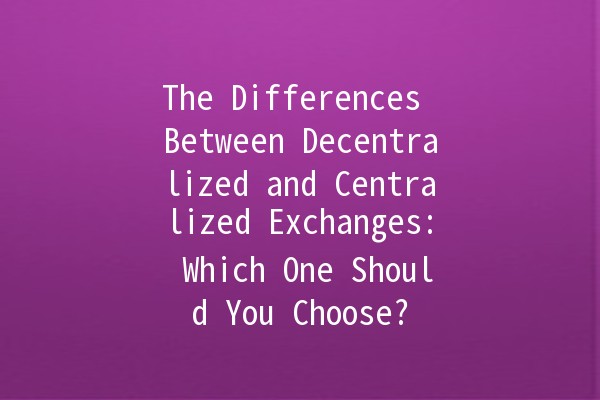




In the world of cryptocurrency trading, two types of exchanges dominate the landscape: centralized exchanges (CEX) and decentralized exchanges (DEX). Each has distinct features, advantages, and challenges. Understanding these differences is crucial for traders, investors, and anyone interested in navigating the digital finance space.
This comprehensive article will delve into the key distinctions between centralized and decentralized exchanges, focusing on how they operate, the benefits and downsides of each, and offering practical tips for utilizing these platforms effectively. We will also explore how to enhance your trading productivity.
Centralized exchanges are platforms operated by centralized entities that facilitate trading between users. Some of the most wellknown examples include Binance, Coinbase, and Kraken. Here's how they work and what you need to consider:

Security Risks: Being centralized means they are prime targets for hackers. Highprofile hacks have led to significant losses for centralized exchange users.
Lack of Control: Users do not own their private keys; instead, the exchange holds them. This creates counterparty risk.
Regulatory Scrutiny: Centralized exchanges are more likely to face regulatory challenges, impacting their operations.
Decentralized exchanges operate on a peertopeer basis, allowing users to trade directly with one another without an intermediary. They leverage blockchain technology smart contracts to automate the trading process. Examples include Uniswap, SushiSwap, and PancakeSwap. Here are their primary characteristics:
Complexity: DEX platforms may be less userfriendly, which can intimidate new traders.
Lower Liquidity: Many DEXs experience lower trading volumes compared to centralized exchanges, potentially leading to slippage in trades.
Limited Customer Support: With no central authority, assistance may be scarce if users encounter issues.
| Feature | Centralized Exchanges | Decentralized Exchanges |
||||
| Control over Assets | Exchange holds private keys | Users hold their own private keys |
| User Experience | Userfriendly interfaces | May be complex for novices |
| Liquidity | Higher liquidity | Variable liquidity |
| Fees | Typically higher fees | Generally lower fees |
| Regulatory Issues | Subject to regulations | More resistance to regulation |
| Support | Customer support available | Limited support |
| Asset Availability | Selective tokens | Access to a wide range |
Explanation: Before choosing between a CEX and a DEX, evaluate your trading preferences, experience level, and asset requirements.
Examples:
If you are new to trading and value a userfriendly interface, a centralized exchange might be more suitable.
If you prioritize asset control and lower fees, consider using a decentralized exchange.
Explanation: Security is paramount, especially on centralized exchanges. Enable twofactor authentication (2FA) to add an additional layer of protection to your account.
Examples:
Use 2FA apps such as Google Authenticator or Authy.
Ensure you back up your 2FA recovery codes.
Explanation: Whenever possible, transfer your assets from the exchange to a hardware wallet to minimize the risk of theft.
Examples:
Popular hardware wallets include Ledger and Trezor.
Always keep your recovery seed phrases secure and offline.
Explanation: Understanding the token standards (like ERC20 for Ethereum) can help you navigate DEXs more effectively.
Examples:
Verify the tokens you wish to trade are compatible with the DEX you are using.
Research tokens before trading to avoid scams.
Explanation: When trading on DEXs, be mindful of varying gas fees, especially on networks like Ethereum. High gas fees can eat into your profits.
Examples:
Use tools such as GasNow or ETH Gas Station to keep track of current gas prices.
Consider trading during offpeak hours to save on fees.
Explanation: The cryptocurrency landscape is evolving rapidly, and regulatory changes can impact your trading strategy.
Examples:
Follow news sources and forums dedicated to cryptocurrency regulations.
Engage with communities on platforms like Reddit and Twitter to stay informed.
While DEXs offer better control over your funds compared to CEXs, they are not entirely riskfree. Users must be cautious regarding smart contract vulnerabilities and ensure they are using reputable platforms.
Yes, users can convert their assets by transferring them from one platform to another. However, be mindful of withdrawal fees and transaction costs associated with each exchange.
Tax treatment for cryptocurrency transactions varies by jurisdiction. It is important to keep accurate records of your trades and consult with a tax professional regarding local regulations.
For beginners, centralized exchanges such as Coinbase and Binance offer userfriendly experiences and customer support. However, newcomers should also consider a simple DEX like Uniswap for direct trading.
To ensure liquidity on a DEX, consider trading popular pairs or those with established trading volumes. Engaging in the community can also help identify emerging tokens.
Yes, many ICOs are now launched on DEX platforms due to their decentralized nature. However, several CEXs also support token listings and ICOs, offering different options for investors.
Understanding the differences between decentralized and centralized exchanges is crucial for anyone looking to trade cryptocurrencies. Each exchange type offers unique benefits and challenges, and the choice between them depends on individual preferences, experience levels, and specific trading needs. By implementing the aforementioned tips, traders can enhance their trading productivity and navigate the cryptocurrency landscape more effectively, mitigating risks and maximizing opportunities.
Whether you opt for the convenience of centralized exchanges or the autonomy offered by decentralized ones, staying informed and adaptable is key to thriving in this everevolving market.